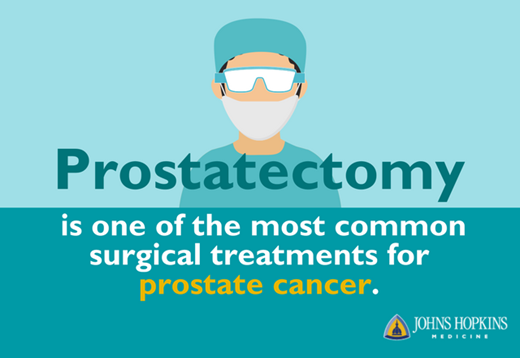Prostate Cancer: Treatment Advancements You Should Know About
Featured Expert:
Urologist Christian Pavlovich, M.D., who specializes in urologic cancers, reviews an array of newer techniques for surgery that are improving the outlook for patients with prostate cancer.
Radical prostatectomy (a surgery that removes the entire prostate and regional lymph nodes if indicated) is one of the most common treatments for prostate cancer. If your doctor has recommended this surgery, you may have many questions, including:
- What does the surgery entail?
- Will I need more treatment after surgery?

As one of the most experienced prostate cancer treatment centers in the world, The Johns Hopkins Hospital’s dedicated urology team has performed thousands of robotic prostatectomy procedures. Here’s what Johns Hopkins urologist Christian Pavlovich, M.D., wants you to know.
Radical Prostatectomy: Advanced Techniques
Refined techniques of minimally invasive access to the pelvic area have changed the way doctors perform prostate surgery. These techniques can mean much less bleeding and a far lower incidence of complications related to the reconstructed urinary tract, such as bladder neck narrowing.
These techniques can also translate into fewer side effects after surgery, such as:
- Urinary incontinence
- Erectile dysfunction
Radical Prostatectomy Approaches
At Johns Hopkins, our surgeons pioneered radical prostatectomy and currently offer two different surgical approaches:
- The robotic approach (robotic prostatectomy) uses robotic technology to mimic the surgeon’s movements. This surgery is done through either multiple tiny incisions or one central mini-incision, using a laparoscope, a thin, lighted tube equipped with a camera. Robotic surgery lets your doctor see the prostate in high detail, highly magnified and in three dimensions. The surgeon can guide precision instruments into the immediate area of the prostate and control them remotely.
- The open approach is more traditional and involves an incision below the patient’s navel. There are still experts in open radical prostatectomy at Johns Hopkins, which is where this approach was first made safe and effective.
After Prostatectomy: More Treatment Needed?
You may be wondering whether you’ll need further cancer treatment after a prostatectomy.
Your doctor will contact you with the final pathology report after surgery. These results will help guide any further treatment-related decisions, as will post-operative PSA testing. While each individual is different, most men do not need any more treatment after a radical prostate removal.






